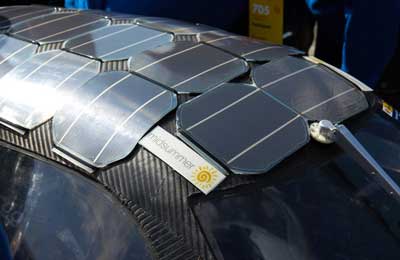
CIGS layer....thickness reduced from 2,000 nm to 800 nm
Solar cell leader slashes CIGS layer thickness
STOCKHOLM, SWEDEN, November 26, 2014
Midsummer, a leading supplier of production lines for cost effective manufacturing of flexible thin film copper indium gallium selenide (CIGS) solar cells, has reduced its CIGS layer thickness to 800 nanometres (nm), less than half of what other suppliers can offer, the company said.
Sven Lindström, chief executive officer, said: “This puts the foundation for low manufacturing cost, which further strengthens the business case and attractiveness for Midsummer’s thin film CIGS solar cells.”
The firm had revealed earlier this year that it has managed to increase the efficiency of the whole solar cell to 16.2 per cent aperture area of the full 156×156 mm cell, said a statement.
Since then, it has raised the efficiency from 16.2 per cent to 16.7 per cent on 156x156mm aperture area. With the help of a new aggressive grading of the CIGS layer, they have also been able to thin it out to 800nm; normally the thickness of the CIGS layer is 2,000 nm or two microns.
A thinner CIGS layer has a number of advantages as the CIGS is the most expensive layer in the solar cell. Therefore, reducing the thickness has major cost advantages.
Additionally, if the CIGS layer is reduced, the production time is reduced which increases productivity. A thinner CIGS layer also means that it takes less energy to coat the layer. It also reduces the time during which the substrate needs to be kept warm.
“Considering that the solar cell is made on stainless steel substrates, contains no cadmium buffer layer and that the production process is an all-dry, all vacuum process where all layers (including the buffer layer) are deposited by sputtering, this achievement by our engineers is truly impressive. By halving the thickness of the CIGS thin film solar cell the manufacturing cost will be significantly reduced, which further strengthens the business case”, said Lindström.
Midsummer’s scientists see the opportunity to reduce the thickness even further with a reflective back contact, that is any photons that have passed through the CIGS layer would be reflected and have the chance to do work on the way back.
“Our scientists are constantly working on reducing the thickness and they will now start to work on this opportunity. As soon as we are done we will report it. We are always aiming to increase the productivity in our machines while many of our competitors are chasing records, which means their CIGS-layers turn out to be thicker than ours,” Lindström added. - TradeArabia News Service







